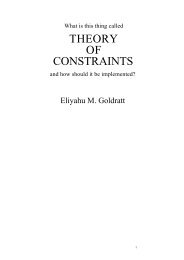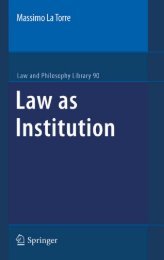Making of a German Constitution : a Slow Revolution
Making of a German Constitution : a Slow Revolution
Making of a German Constitution : a Slow Revolution
Create successful ePaper yourself
Turn your PDF publications into a flip-book with our unique Google optimized e-Paper software.
172 • The <strong>Making</strong> <strong>of</strong> a <strong>German</strong> <strong>Constitution</strong>the separation <strong>of</strong> the sexes wherever possible in the workplace. Paragraph 120called for separation ‘on the shop floor, in cafeterias, courtyards, and washrooms’,for example. 26 Indeed as the century wore on, Social Darwinism also came to theaid <strong>of</strong> liberal demands for sex guardianship. The infusion <strong>of</strong> Social Darwinism into<strong>German</strong> legal thought was present in Jhering’s Der Kampf ums Recht (1872), whichreacted against the dominance <strong>of</strong> the historical school. 27 This element came throughclearly in Geyer’s summary article, ‘Der Kampf ums Recht’ (1873), which appearedin Der Gerichts saal. 28 Although new arguments rested on an alternative scientificfoundation, the demand for female exclusion remained consistent with thesystems developed by Grimm and others.Despite the infusion <strong>of</strong> Social Darwinism into legal thought, on the whole, thewritings <strong>of</strong> the <strong>German</strong>ists remained the dominant source <strong>of</strong> political discourse.When later generations <strong>of</strong> <strong>German</strong>ist scholars encountered the unfortunate contradiction<strong>of</strong> existing conditions, they routinely invoked immemorial customary lawto support their views. One <strong>of</strong> the most important legal histories <strong>of</strong> early twentiethcentury was Rudolf Hübner’s Grundzüge des deutschen Privatrechts (1908). Heopened his discussion on civil marriage by freely recognizing and listing a number<strong>of</strong> secondary sources that acknowledged the fact that the forms <strong>of</strong> marital unions wererecognized as legal in an earlier period. However, he drew distinction between aunion and marriage, asserting the legitimacy <strong>of</strong> the heterosexual model. ‘Althoughdifferent varieties <strong>of</strong> sexual union were once not only actually practiced but also recognizedby law’, he wrote, ‘nevertheless marriage, as that form <strong>of</strong> sexual community,which involved the most far-reaching legal consequences, was always distinguishedby a special form observed in its creation, on the strength <strong>of</strong> which it, alone, wasconceded its privilege <strong>of</strong> full legitimacy’. 29Hübner’s Grundzüge goes on to summarize the consensus <strong>of</strong> nineteenth-centuryscholarly opinion on the history <strong>of</strong> eheliches Güterrecht. It is worth examining herefor several reasons. First, <strong>German</strong>ists acknowledged that the long-term evolution <strong>of</strong>marital property relations had resulted in changes that were favorable to women. Maritalproperty relations had advanced well beyond the administrative community (Verwaltungsgemeinschaft).Second, Hübner <strong>of</strong>fered a description <strong>of</strong> the five basic systems <strong>of</strong>marital property relations that were identified by the <strong>German</strong>ists and that will be usefulwhen I examine the state reports later in this chapter. Finally, Hübner’s work serves anadditional purpose as a primary source. He acknowledged that this progressive trendwas reversed with the reintroduction <strong>of</strong> the Verwaltungsgemeinschaft—the system <strong>of</strong>marital property relations, which was preferred by liberal <strong>German</strong>ists and which theyidentified as the customary law <strong>of</strong> the ancient <strong>German</strong>s.By 1908 when Hübner wrote, the BGB had been the law <strong>of</strong> the land for eightyears. It is taken up before our discussion <strong>of</strong> the BGB, however, to show how historywas used to justify innovations that liberals knew were regressive at the time theywere introduced. More than anything else, Hübner’s Grundzüge summarized the




